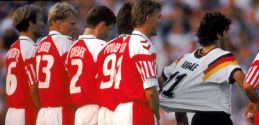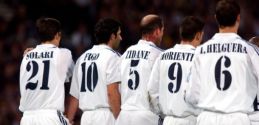
The aesthetically challenged world of football
by Robert O’Connor
Football in 2013 looks awfully different to what it did twenty years ago. I’m not talking about the big changes like the way the telly and the agents and the egos have whipped it up into a money-mad frenzy where angels, honour and scruples fear to tread. Nor the way that the cogs turn, or the labourers who are contracted in to jam them into place in exchange for a ha’penny bit and a spam sandwich. Not the fundamentals, rather the superficial bits. The customer-facing accessories that speak to the fashion-conscious, trend-following zealot in us, rather than the socially-aware, economically-savvy critic.
I’m talking about the bits that excite the child in us, rather than what sends heads crashing deeper and deeper into the hitherto unchartered ridges of our palms. The changing aesthetic is, of course, all part of the same process that has seen the game bloat up like some great dead toad as investors and speculators from the four corners of the universe find new holes to jam their money hoses into.
David Silva running rings around a hapless Matthieu Debuchy as Man City woo another thousand or so global disciples and the pre-Enlightenment state of trade union laws in the UAE that has helped the Etihad ‘project’ come to life are really just two side of the same coin – albeit one rather shiner than the other. The re-modelling that has turned the game from something you’d expect to find parked on a shelf between a roll of extension cable and spark plugs in a DIY store in Bolton (circa 1989) into the West End packaged, re-mortgage-your-wife-just-to-afford-the-deposit luxury knick-knack that dominates our attentions today has been a fascinating evolution. Here are some of its more conspicuous features.
Square Nets:
Remember when the goal nets were left alone to droop peacefully from their posts, making a soft hypotenuse that bellowed playfully when struck by the ball? At one time it was one of the great international symbols of the game, as recognisable and reproducible as the ball itself, but those indulgent, decadent drapes are long gone now from a game that is all angles and sharp edges.
They can still be found collecting balls in the lower leagues and on Sunday morning kick-abouts, which probably goes a long way towards explaining why the high-end of the game has turned its back on its old friend. The phasing out began in the mid-nineties in the aftermath of the ‘94 World Cup – the first of many Americanisms that would begin re-weaving the domestic game around that time – and the anachronistic triangles disappeared for good from the top-flight when Leicester City’s Filbert Street closed its turnstiles in 2003.
There are fewer and fewer of them around in the Football League these days – on a recent trip to Wingate and Finchley I found even the nets in the sixth tier hanging to attention from those pointy iron gallows behind the goal – and those that are still clinging to the past (looking at you Walsall’s Bescot Stadium) look like they’re doing just that.
Named Shirts:
It was one of the more minor points of detail when the Premier League farted into life in 1992 that each player would have a squad number, to borrow protocol from the NFL. A year down the line having made precisely zero impact on anybody’s experience of the new league we were treated to players’ surnames glued on clumsily in block lettering so thick it looked as if it doubled the weight of the shirts.
Looking back it was the first in a long line of steps that leached the idea of the individual out of the collective team effort and the cult of the personality by which the Premier League is trademarked can probably be traced back to this act of perpetual self-promotion. Much like the big square nets the big square names added nothing besides one more thing for spectators to notice besides the actual football taking place. The league and its media partners have been adding relentlessly to this list ever since.
Coloured Boots:
With all the money and energy that presumably goes into designing football strips (I say presumably. The Stoke City away kit looks like it’s been stolen from a survivor of a food fight in a nuclear waste facility) it seems self-defeating to then allow players free-reign to accessorize them with ghastly glowing footwear that looks like it’s been pulled out of a clothes bank in the seventies.
There was a time when a pair of white boots on a pitch would have had audiences cooing at the sheer ostentatious whimsy of their presence. I know, because I was there and I cooed. But before this becomes a ‘what’s hot and what’s not’ of sartorial sport, suffice to say this: white goes with anything.
If Yeovil Town are playing Blackpool the green and orange melange will be offset by a palatable, neutral white boot. When Stewart Nelson steps out in his all red Gillingham goalkeeper’s kit offset with neon green shoes he looks like he’s been emptied out of the stomach pump bag after a long Saturday night in A&E.
Pitch Patterns:
Are football club groundsmen trying to communicate something to us in code? Something at once sensitive and urgent enough that it must be wrapped up in an Enigma-defying tapestry of carefully and confusingly groomed football pitches?
I was at Molinuex last weekend and I felt throughout that the immaculate weaving that had taken place among the blades was itching to reveal a secret locked in so tightly even the man with the keys to the lawnmower knew of no way in. The truth is out there and only the football pitches have heard it. I can think of no other explanation.
More of Robert O’Connor’s writing can be seen on his brilliant blog and he can also be found on Twitter
Image: Flickr / laffy4k
Tags: , , , , Championship, Premier LeagueShare this article
Leave a comment
- When did co-commentary become such a serious and miserable business?
- Why do we devote so much time to sharing our love of football for free?
- Villa’s Tokyo downfall: The apparent formality of a world title match
- Son Heung-min and the forgotten wonder goals
- Guess the Premier League goalscorer from the GIF
- A fateful flight
- Goodbye to the instant analogue gratification of Ceefax
- Player Profile: Steve Ogrizovic
- Rejecting FA Cup money in favour of a car boot sale
- It’s a man’s world? Former Arsenal manager crosses the gender divide











